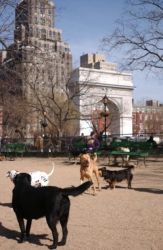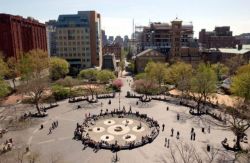Washington Square Park
Shirley Hayes and the Preservation of Washington Square Park
In the early 1950s, the City of New York proposed running a four-lane, partially sunken roadway through the middle of Washington Square Park. In February 1952, Mrs. Shirley Hayes (1912-2002), a young mother of four sons (Dennis, Timothy, Christopher, Kerry) living in Greenwich Village, discovered the city’s plans to link Fifth Avenue—which at the time ran through the park—with West Broadway in an attempt to alleviate downtown traffic congestion. The measure, approved by the City Planning Board and then Parks Commissioner Robert Moses, would have removed the park’s fountain and allowed cars and buses to cut right through the heart of the park.
Established as a public park in 1827, Washington Square Park is a historic open space and the home of many monuments including the marble Washington Arch, a statue of Italian nationalist leader Giuseppe Garibaldi, a bust of engineering innovator Alexander Lyman Holley, and a World War I memorial flagpole. Mrs. Hayes and many others believed the plan to run a new major artery through the park would compromise the historic character of the Village and deny thousands of local residents and visitors the only large green space in their neighborhood. Pitted against opposition from City Hall, the Board of Estimate, New York University, and elected officials, Mrs. Hayes began a fight to “Save the Square” that lasted for seven years. In addition to being appointed to the Manhattan Borough President’s Greenwich Village Community Planning Board to help find an alternate plan for the park, she founded the Washington Square Park Committee, composed of 36 community groups including property owners, civic organizations, parent-teacher associations, and churches. As the leader of this effort, she was said at the time to be the “true Village Voice.” She spoke out against the city’s plan and urged the community to remember that “some provision for healthy family living and some vestige of quiet and beauty must be allowed to survive.”
As neighborhood support for Mrs. Hayes’s campaign grew, a number of alternate plans were proposed. In 1955, Manhattan Borough President Hulan E. Jack unveiled a plan to build a depressed roadway through the park, while community leaders including Anthony Dapolito tried to negotiate with the city, suggesting alternatives including the construction of a tunnel beneath the park. Raymond S. Rubinow, Chairman of the Joint Emergency Committee to Close Washington Square Park to Traffic, formulated a “turn-around” compromise plan—endorsed by Tammany Hall’s Democratic party leader Carmine DeSapio—that would allow only Fifth Avenue Coach Company buses to use a traffic lane around the Washington Arch.
Mrs. Hayes and her community allies rejected these proposals, saying that only one alternative would “best serve the needs of children and adults of this family community.” Mrs. Hayes proposed that Washington Square Park be forever closed to all motor vehicles. Her plan, calling for one and three-fourths acres of existing roadways to be transferred to parkland and a paved area to be used for emergency use only, received widespread support from community members, including then Congressman John V. Lindsay (Mayor 1966-1973) and Charles McGuinness of the Village Independent Democrats. She believed the unification of the park would create a better venue for cultural and recreational activities such as the Shakespeare Festival, outdoor concerts, and art exhibits.
In 1958, a public hearing was held to discuss the roadway through the park. Bus loads of supporters—including Eleanor Roosevelt, a resident of 29 Washington Square Park West—crowded into City Hall to support Mrs. Hayes. With Assemblyman William F. Passanante, Manhattan Borough President Hulan E. Jack, and other community leaders in attendance, a “ribbon tying” ceremony was held on November 1, 1958, to celebrate the start of a trial period by Traffic Commissioner T. T. Wiley to close the park to all vehicles except buses. Months later, the experiment was extended to prohibit buses from the park altogether, and after a period of evaluation, a final decision on the park was to be made. In August 1959, Mrs. Hayes and her supporters were victorious in their battle at last, and the Board of Estimate closed the park to vehicular traffic for good. Today, this sign and a unified Washington Square Park stand as a testament to Shirley Hayes and her heartfelt dedication that brought the entire Greenwich Village community together in a true grassroots movement to “Save the Square.”
Check out your park's Vital Signs
Clean & Safe
Green & Resilient
Empowered & Engaged Users
Share your feedback or learn more about how this park is part of a
Vital Park System










